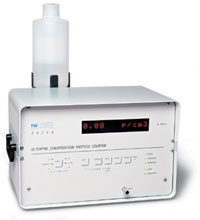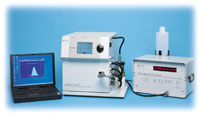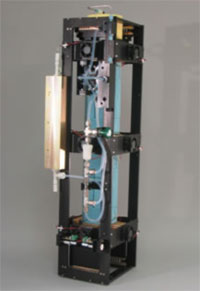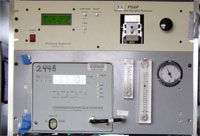Aerosol Research Instrumentation

TSI Model 3563 Integrating Nephelometer
State-of-the-art instrumentation plays an essential role in understanding the radiative effects of aerosol particles on climate change. The Atmospheric Sciences and Chemical Sciences Divisions at Pacific Northwest National Laboratory actively acquire, use and evaluate key instruments for determining the chemical, physical and optical properties of atmospheric aerosols that are used in laboratory, surface and airborne measurements and characterization of aerosol properties.

TSI Model 3010 Condensation Particle Counter
The chemical composition, size and number of particles in a unit volume of air determine the light extinction (scattering and absorption) properties and, therefore, the radiative forcing potential of the aerosol. Aerosol optical properties can be calculated from measured physical parameters of aerosols (size, number, water up-take potential, and refractive index) and chemical composition (needed to determine water up-take potential and refractive index). Aerosol light scattering arises primarily from inorganic and organic species, while aerosol light absorption arises from elemental carbon.

TSI Model 3025A Ultrafine Condensation Particle Counter
At present, the following aerosol characterization measurements can be made using the appropriate instruments (in parenthesis):

TSI Model 3961 Scanning Mobility Particle Sizing System
Particle number concentration:
- Condensation Particle Counters for measuring total particle number concentrations for particles larger than 3 nanometers (nm) (TSI Model 3025) and 12 nm (TSI Model 3010).

Sunset Laboratory Organic Carbon / Elemental Carbon Analyzer
Particle size distributions:
- Optical particle counter for sizing particle concentrations in the size range from 0.1 micrometer (?m) to 3 ?m with selectable size-bin ranges (Droplet Measurement Technologies / Particle Metrics Inc. Passive Cavity Aerosol Spectrometer Probe) and differential electrical mobility analyzer systems for sizing particle concentrations in the size range from 3 nm to 1 μm (TSI Model 3961 Scanning Mobility Particle Sizing System, TSI Model 3080 Electrostatic Classifier).

Droplet Measurement Technologies Cloud Condensation Nuclei Counter
Particle chemical composition:
- Semi-continuous bulk organic carbon / elemental carbon composition (Sunset Laboratory OCEC Analyzer)
- Real-time single particle composition of major inorganic (sulfate, nitrate, ammonium) and some organic species (Aerodyne Aerosol Mass Spectrometer)
- Time-resolved aerosol collector (TRAC) for post-analysis of particle composition (PNNL-built)

Particle Metrics Passive Cavity Aerosol Spectrometer Probe PCASP-100x
Particle optical properties:
- Total aerosol light scattering and hemispheric backscattering coefficients at 3 wavelengths (TSI Model 3563 Integrating Nephelometer)
- Aerosol light absorption coefficients at 3 wavelengths (Radiance Research Model Particle Soot Absorption Photometer)
- Aerosol optical depth (total column light extinction through the atmosphere) using a PNNL / Yankee Environmental Systems multi-wavelength rotating shadowband radiometer (MFRSR)

Radiance Research Particle Soot Absorption Photometer (PSAP) and TSI Model 3010 CPC
Aerosol-cloud interactions:
- Continuous flow, single super saturation, cloud condensation nuclei counter (Droplet Measurement Technologies)

Yankee Environmental Systems Multifilter Rotating Shadowband Radiometer (MFRSR)
Additional specifications for many of these instruments can be found at Grumman Gulfstream-1 Aircraft.

